Hong Kong’s Studio One cinema club

No doubt reminiscing is a natural consequence of growing older – the danger lies in reminiscence atrophying into nostalgia. For various reasons, I have been thinking a lot about the past (particularly my David Lynch-related experiences) and was recently diverted from keeping up here on the blog with my current movie-watching when I unearthed some material from my eight-month stay in Hong Kong from the Fall of 1980 to the Spring of 1981 – during which I wrote my original critical essay about Eraserhead, which led to my three-year encounter with Lynch himself, first through the writing of my history of Eraserhead, then working on Dune in Mexico.
The materials in question are eight monthly programs from Studio One, a cinema club which programmed an eclectic assortment of classics and contemporary movies from around the world, ranging from the very highbrow (Abel Gance’s Napoléon) to the decidedly lowbrow (National Lampoon’s Animal House). I bought a membership soon after I arrived in Hong Kong and each month during my stay, when the new schedule was announced, I would buy my tickets – not for every movie, though looking over the programs now I couldn’t say how I made all those choices. It was no doubt partly just a matter of how much time I had – I was also seeing movies at regular theatres, which was an experience in itself. Those theatres were usually packed and redolent of the snacks popular with Chinese audiences; no popcorn, but numerous packages of dried squid which released a strong fishy odour into the auditorium.
I would occasionally revisit a familiar film at Studio One, but more importantly the club introduced me to new filmmakers and gave me an opportunity to finally see some classics I’d read about but which had previously been inaccessible. The club didn’t have its own theatre, but screened movies at several different venues – a pair of auditoria in the Hong Kong Arts Centre and the City Hall Theatre – all relatively small compared to commercial cinemas. It had actually been in operation since 1962, run by cinephiles and enthusiasts, and eventually closed in the ’90s; one of the amusing things to be gleaned from the programs is the fact that they would book movies sight unseen, based on what critics elsewhere had said, or on the director’s reputation – there are numerous instances in which whoever wrote the notes in the program hedged by warning that they couldn’t actually vouch for the film in question, essentially saying don’t blame us if it’s a dud.
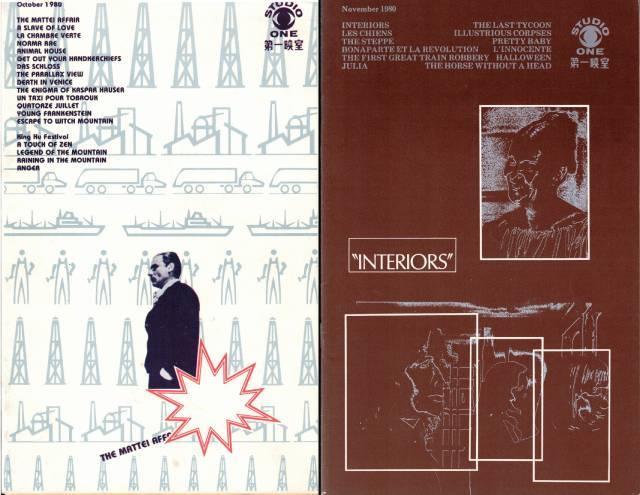
October 1980
The month I arrived in Hong Kong, October 1980, I quickly became aware of the club because they hosted a mini-festival of four King Hu movies, which were highly recommended to me. I was too late to catch the opening film, A Touch of Zen (1971) – that would have to wait until the Hong Kong International Film Festival the following April – but I did see Legend of the Mountain, Raining in the Mountain (both 1979) and Anger (1970), a short film made as part of an omnibus called Four Moods. I’ve never had an opportunity to see this last again, but have revisited the others numerous times since the advent of DVD and Blu-ray. Having only just arrived in Hong Kong, these movies were something like jumping in at the deep end of an unfamiliar culture; this was the start of a decades-long love of Chinese cinema which continues unabated today.
November 1980
The King Hu screenings also introduced me to Studio One and I immediately bought a membership. According to my notes, it looks like I went to five screenings in November. I’m afraid I have little memory of Elia Kazan’s The Last Tycoon (1976), adapted by Harold Pinter from F. Scott Fitzgerald’s unfinished novel, as I haven’t seen it again; my records give it only an average score, so I assume I wasn’t overly impressed (yes, I’ve kept a notebook for more than fifty years in which I list everything I’ve seen and rate it on a four-star scale); the cast is certainly interesting, so perhaps I should seek it out for another look. I also haven’t seen Sergei Bondarchuk’s The Steppe (1978) again, but that did leave a strong impression – I loved its wonderful evocation of landscape and the way place shapes character, drawing out the nuances of Chekov’s short story through a leisurely pace and careful attention to detail and mood.
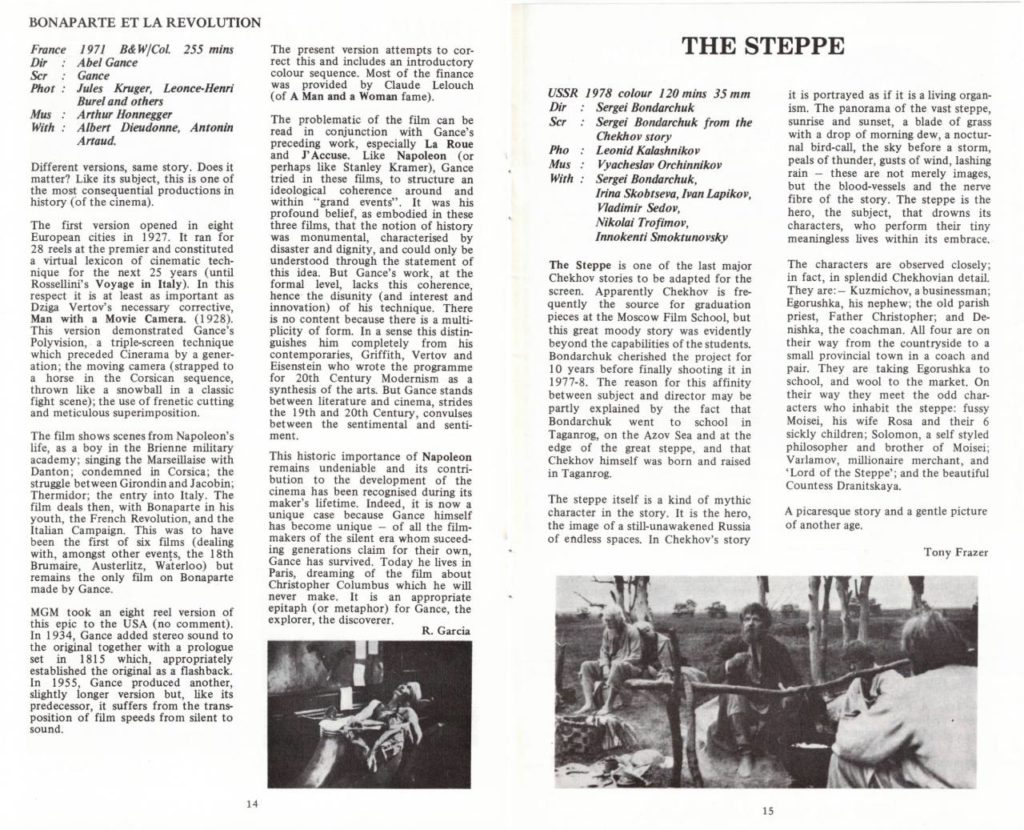 I liked Francesco Rosi’s Illustrious Corpses (1976), though again I don’t remember it well (it has been forty-four years after all!); but there’s a copy of Kino’s Blu-ray in my to-watch pile, so I’ll revisit it at some point. I did take another look at Alain Jessua’s Les Chiens (1978) last year and completely revised my original negative opinion – back in 1980 I considered it a complete dud; seeing it again, I found it to be an interesting and effective combination of thriller and political allegory.
I liked Francesco Rosi’s Illustrious Corpses (1976), though again I don’t remember it well (it has been forty-four years after all!); but there’s a copy of Kino’s Blu-ray in my to-watch pile, so I’ll revisit it at some point. I did take another look at Alain Jessua’s Les Chiens (1978) last year and completely revised my original negative opinion – back in 1980 I considered it a complete dud; seeing it again, I found it to be an interesting and effective combination of thriller and political allegory.
There are now numerous versions of Abel Gance’s Napoléon, originally made as a silent epic in 1927, revised with the addition of sound in the early ’30s, and reconstructed several times since then, with running times varying between 235-minutes and 425-minutes. The version shown at Studio One was Bonaparte et la révolution, largely financed by Claude Lelouch in 1971, running at that time 255-minutes, though later expanded with additional material. My most distinct memory of that long evening was of a seemingly endless visual spectacle, which was extended after the credits when the projectionist appeared to apologize and explain that he’d found another reel which had been inadvertently skipped during the screening – we all settled back into our seats and watched more spectacle which belonged somewhere in the middle of the film. I’m not sure that this out-of-sequence experience really mattered. Like Gance’s J’Accuse (1919) and La roue (1923), Napoléon is an exhausting display of technique – Gance was a formidable technical innovator – with form overwhelming content. These films are narratively inert as they foreground a wide array of camera techniques, which in themselves are interesting, but have the effect of keeping the audience at an emotional distance rather than drawing them in. Perhaps this would work better in small doses, but Gance stretches his films to interminable lengths.
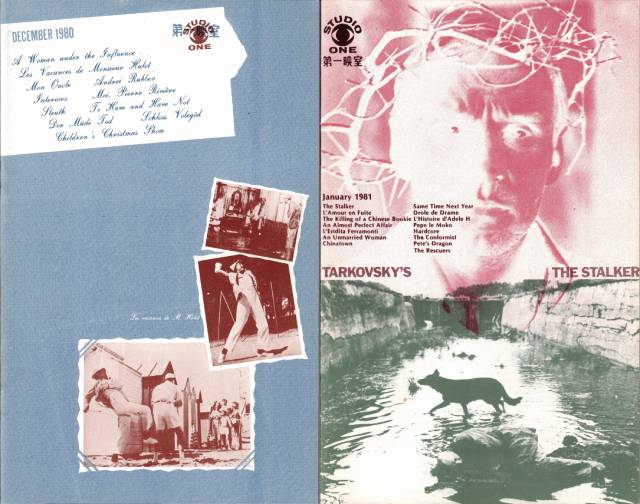
December 1980
The next month included another lengthy historical epic, but one which did engage on both an emotional and intellectual level: this was the first time I saw Andrei Tarkovsky’s Andrei Rublev (1966) and it inspired a passion for his work which has stayed with me ever since. I had previously seen, and very much liked, Solaris (1972), but Andrei Rublev was on a whole other plane. Strangely, the program notes list a running time of only 150-minutes, so I’m not sure whether what I saw then was actually a truncated version – more likely, it was a typo as I’m almost certain I saw the full-length film I’m now so familiar with.
The rest of the December screenings somewhat pale beside Tarkovsky’s epic and I’m afraid I didn’t rate any of them particularly highly, other than Howard Hawks’ To Have and Have Not (1945), a trifle perhaps, but nonetheless one of Hawks and Bogart’s most enjoyable collaborations.
A Woman Under the Influence (1974) was the first John Cassavetes movie I’d seen, though I already knew his reputation, and had certainly seen him as an actor numerous times by then (most recently in Brian DePalma’s The Fury [1978]). Having since seen most of the movies he directed, I know that what rubbed me the wrong way about Woman is an integral element in his work – his indulgence of his actors and his unwillingness to rein in their often overwrought performances. I can recognize that Woman Under the influence is one of his better films, but scenes drag on and the intense psychodrama at times pushes close to the edge of self-parody (a tendency displayed most egregiously in the almost unwatchable Husbands [1970]).
This “investigation” serves as a reminder that, in six-plus decades of watching movies, I have forgotten more films than I can recall. What makes something I saw once long ago remain in memory while something else has simply vanished? I have no idea. This aspect of memory underlies my unease at times with revisiting a movie I can recall liking, but now fear it won’t live up to the memory – I have been disappointed many times, but then it’s exhilarating when the memory does coincide with the new experience. Even more interesting, perhaps, are those instances when an impression continually shifts over time. Such was the case with Jacques Tati’s Les vacances de M. Hulot (1953). I first saw that as a young child in England and adored it; when I saw it again in Hong Kong, it did nothing for me and I rated it very low. My opinion of Tati has fluctuated over the years and he now ranks as a favourite, with M. Hulot’s Holiday restored to that place it first held when I was five or six.
Rene Allio’s Moi, Pierre Rivière (1976) belongs in that other category, a forgotten film – my rating at the time was average, but it seems like something I would really appreciate now; a film based on historical documents (compiled by Michel Foucault) using a cast of non-actors who lived in the area where the events occurred in the early 19th Century, illuminating the class-oppressed culture of the time. I’d definitely be interested in seeing it again, but it doesn’t appear to have been released on disk. (There is an unsubtitled copy on YouTube, but I’m sadly not bilingual.)
December was rounded out with a pair of early films by masters of Weimer cinema, both made in 1921, and neither of which has attained the stature of either filmmaker’s most famous work. Despite its title, F.W. Murnau’s Schloß Vogelöd aka The Haunted Castle isn’t a horror film, but rather a kind of Old Dark House story in which a hunting party gathered at a country house are faced with a man trying to clear himself of a past crime, in fact the murder of his own brother. Murnau hadn’t yet developed the subtlety and expressive technique which distinguish his great films, but after one more feature he created one of the defining films of German Expression the next year with Nosferatu (1922).
Fritz Lang, on the other hand, had already made the first of his major serials – Die Spinnen (1919-20) – and several other features, including Harakiri (1919), a version of Madame Butterfly, before co-writing (with Thea von Harbou) and directing Der müde Tod (Destiny), a three-part narrative echoing D.W. Griffith’s Intolerance (1916). Weary of his role, Death offers a woman three chances to save her fiance – he will transport her into three different historical periods in each of which she must try to save the life of someone destined to die. If she succeeds in saving just one of them, he will spare her fiance. This structure gives Lang an opportunity to explore a number of exotic settings and visual styles. Destiny launched the first major period of his career, as it was followed by Dr. Mabuse, Die Nibelungen, Metropolis, Spies, Woman in the Moon and then his first sound films, M and Testament of Dr. Mabuse, which capped his German period before going into exile in France and Hollywood.
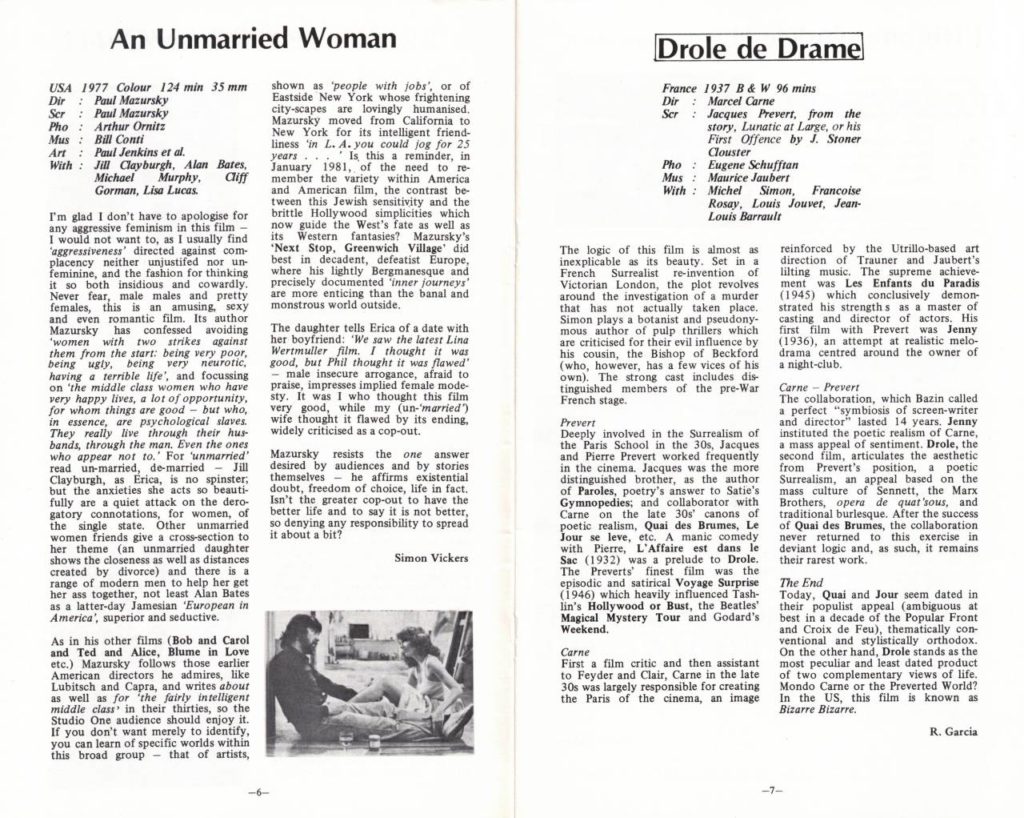 January 1981
January 1981
My sampling of the January schedule was dominated by French films, two from 1937 and two by François Truffaut. Of the New Wave directors, Truffaut has always been a bit harder to pin down than, say, Jean-Luc Godard or Claude Chabrol, whose work is more clearly defined by theoretical (Godard) and thematic (Chabrol) concerns. Truffaut certainly had an abiding interest in romantic/sexual complications, generally in a middle-class setting, but often his approach seemed rather lightweight, even facile. After his debut with The 400 Blows (1959), a harsh portrait of a grim childhood, he followed that film’s protagonist, Antoine Doinel, through four more films, ending with L’amour en fuite (1979), which uses what amounts to a clip-show technique to provide a retrospective survey of Antoine’s history of romantic relationships. It’s a movie which probably wouldn’t make a lot of sense to anyone who hadn’t seen the four previous films to which it refers as Antoine deals with divorce and sells an autobiographical novel based on all those relationships.
Much darker is L’histoire d’Adèle H. (1975), one of Truffaut’s best films, in which romantic obsession plunges into madness. Adèle was the youngest daughter of Victor Hugo who, while in exile on the Channel Island of Guernsey was seduced by a British soldier, Lieutenant Pinson (Bruce Robinson, who twelve years later would make his own directing debut with one of the greatest of all British comedies, Withnail & I [1987]). Although he’s a cad who seduces and discards women on a whim, she builds him up in her mind as a romantic ideal and follows him to Canada and the Caribbean, sinking into a solipsistic delusion which eventually has so little to do with the real Pinson that by the end, wandering the streets of Barbados, she no longer even recognizes him. Adèle was a defining role for Isabelle Adjani, making her an international star.
Julien Duvivier’s Pépé le Moko (1937) is also a tale of doomed romance, this time rooted in the poetic realism of ’30s French cinema. Pépé (Jean Gabin) is a gangster who remains beyond the law by hiding out in the Casbah, though he chafes against this self-imposed imprisonment. Ironically, the tough, cynical Pépé falls for a woman trolling Algiers for exotic thrills. Clouded by unexpected romance, the gangster is drawn out of safe hiding by his desire for Gaby (Mireille Balin), love leading to inevitable death. The blend of romance, crime and fate points towards film noir, though the American remake, John Cromwell’s Algiers (1938), softened the darker edges by sentimentalizing Pépé in the form of Charles Boyer.
Drôle de drame (1937), although less revered than the epic-scale Children of Paradise (1945), in many ways epitomizes the collaboration between Marcel Carné and writer Jacques Prévert. This was their second film together, after Jenny (1936), and rather than that earlier film’s realism, it plunges whole-heartedly into absurdist comedy and farce. The farce is French, but the setting and characters are English, more specifically Victorian-era Brits who are eventually tied in uncomfortable narrative knots by their obsession with upholding their class status. A respectable horticulturist supports himself and his wife by pseudonymously writing trashy mysteries. Her cousin, an upright Bishop, publicly condemns these books without knowing the identity of the author. Having invited himself for dinner, the Bishop arrives just as the servants have quit; the wife must cook the meal, while her husband has to create a cover story for her absence… To further complicate things, a serial killer is also targeting the fictitious mystery writer. Loaded with wit and narrative invention, Drôle de drame is a delightful comedy which baffled audiences when it was first released and stood as Carné’s only commercial failure during the ’30s.
I honestly remember nothing at all about Michael Ritchie’s An Almost Perfect Affair (1979), a romantic comedy starring Keith Carradine and Monica Vitti, shot during the Cannes Film Festival and satirizing the movie business. My notes give it a slightly above average rating, so I guess I liked it, but it’s the only Ritchie movie which has left no trace in my memory.
As for Andrei Tarkovsky’s Stalker (1979), I’ve written about it here before. My first encounter was a revelation – and even more than Andrei Rublev, made Tarkovsky one of my life-long idols. It was Stalker which gave me my first clear sense of Tarkovsky’s distinctive rhythms and the remarkable ability he possessed to convey the tactile qualities of nature, his attentiveness to the elemental qualities of the physical world and how those qualities shape human psychology, and how the ways in which we inhabit that world in turn shape how we interpret and give meaning to our experience. Studio One brought the film back a couple of months later and a second viewing confirmed my impressions; I was fully primed for my first encounter with Mirror (1975) three years later.
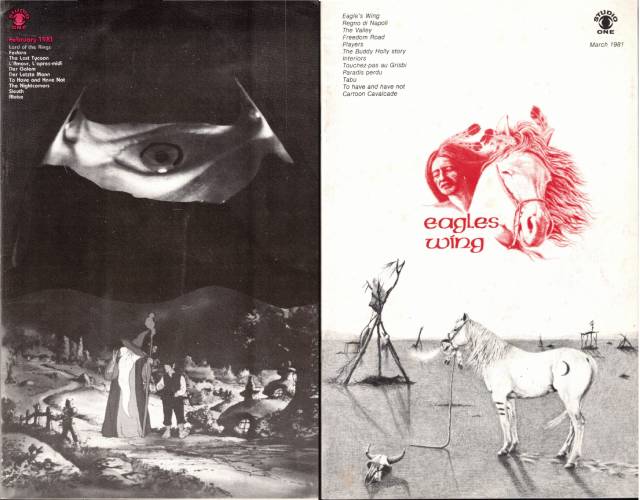
February 1981
The February schedule was less demanding, with a couple more German Expressionist films and a rather random selection of more contemporary features. The former are Paul Wegener and Carl Boese’s Der Golem (1920), released eight months after The Cabinet of Dr. Caligari. Another early exemplar of German Expressionism, it replaced Caligari’s distorted stage sets with an impressively constructed Medieval town. The familiar story of a Rabbi who creates a giant out of clay and uses magic to instill it with life so that it can protect Prague’s Jewish ghetto from a coming pogrom has an air of the fairytale and some echoes of Frankenstein, itself something like an updating of the Golem with a pseudo-scientific rather than magical driver for the plot involving a man-made creature which acquires sentience and acts against its creator’s intentions. Visually impressive, from a later perspective the film’s impact is mitigated by the exaggerated silent acting.
F.W. Murnau’s masterpiece Der letzte Mann (1924), made a few years later, displays far more subtle performances which reveal the psychological nuances of character as the film incisively dissects the insidious effects of a deeply ingrained class structure tied to German militarism. Emil Jannings’ hotel porter draws his entire sense of self-worth from the respect his elaborate uniform gets from his neighbours, so when he’s demoted due to increasing age and finds himself confined to the role of toilet attendant, he has to engage in an elaborate charade to hide his shame. He steals his old uniform so that he can wear it as he leaves for work in the morning and returns home in the evening. But this is brought crashing down when his neighbours learn the truth and respect instantly dissolves into ridicule. The producers insisted that the bleak story be given a happy ending and Murnau complied by concocting a ridiculous coda which rather than mitigating the narrative’s inherent despair actually highlights it by emphasizing the absurdity of the porter’s deliverance through an arbitrary act of fate. Made with virtually no intertitles, Murnau’s film is a stunning display of visual storytelling which uses numerous innovative camera techniques developed by Karl Freund (who by then had a decade-and-a-half of experience on dozens of films, including Der Golem, Murnau’s Der Januskopf [1920], Lang’s Die Spinnen, and just before Der letzte Mann, Carl Th. Dreyer’s Michael [1924]).
While it’s a far cry from Murnau’s artistry, The Nightcomers (1971) is one of my favourite Michael Winner films. Undeniably a crass exercise in hubris – to make a prequel to Henry James’s elegant Victorian ghost story The Turn of the Screw and to couch it in terms of a sordid S&M relationship and murder (by children, no less) is certainly an affront to good taste, but I find it enormously entertaining. I’d seen it before on its original theatrical release, but strangely on this second viewing I gave it a very low rating, apparently disdaining it for the very reasons for which I now embrace it. I have a real fondness for Marlon Brando’s later eccentric performances, ranking his broad Irish gamekeeper Peter Quint up there with his enforcer Lee Clayton in Arthur Penn’s The Missouri Breaks (1976) and his delirious mad scientist in John Frankenheimer’s The Island of Dr. Moreau (1996). Stephanie Beacham as governess Miss Jessel is icing on the cake – I had a huge crush on her back in the ’70s.
Billy Wilder was in his early seventies when he made Fedora (1978), a strange love letter to golden age Hollywood when melodrama was ripe, stars were glamorous, and audiences were looking for entertainment rather than realism. Based on a novella by actor-turned-writer Tom Tryon (from his collection Crowned Heads, four stories about people who had achieved fame in Hollywood, always at some great personal cost), it’s the story of a washed-up producer (William Holden raising inevitable echoes of Wilder’s Sunset Blvd [1950]) who tracks down an elusive star hoping to bring her out of retirement. Fedora (Marthe Keller) has a secret, which is actually not hard to figure out, but as various critics at the time pointed out it doesn’t really matter that you can see the big revelation coming pretty early in the movie. What matters is Wilder’s loving evocation of a bygone age of movie-making, elegantly mounted and steeped in glamour.
The final film I saw that month at Studio One was Liliane de Kermadec’s Aloïse (1975) and I have absolutely no memory of it, despite an obviously impressive cast – Isabelle Hupert, Delphine Seyrig, Michael Lonsdale – but my one-and-a-half star rating indicates that I didn’t like it much. Based on the life of a Swiss woman who became an artist after being confined in an insane asylum, it apparently belongs to the wave of feminist films which were revising cinema’s perspective on women’s experience (like Chantal Akerman’s Jeanne Dielman [1975]). From the few comments I’ve found on-line, it’s apparently a polemic wrapped up in an elegant period film.
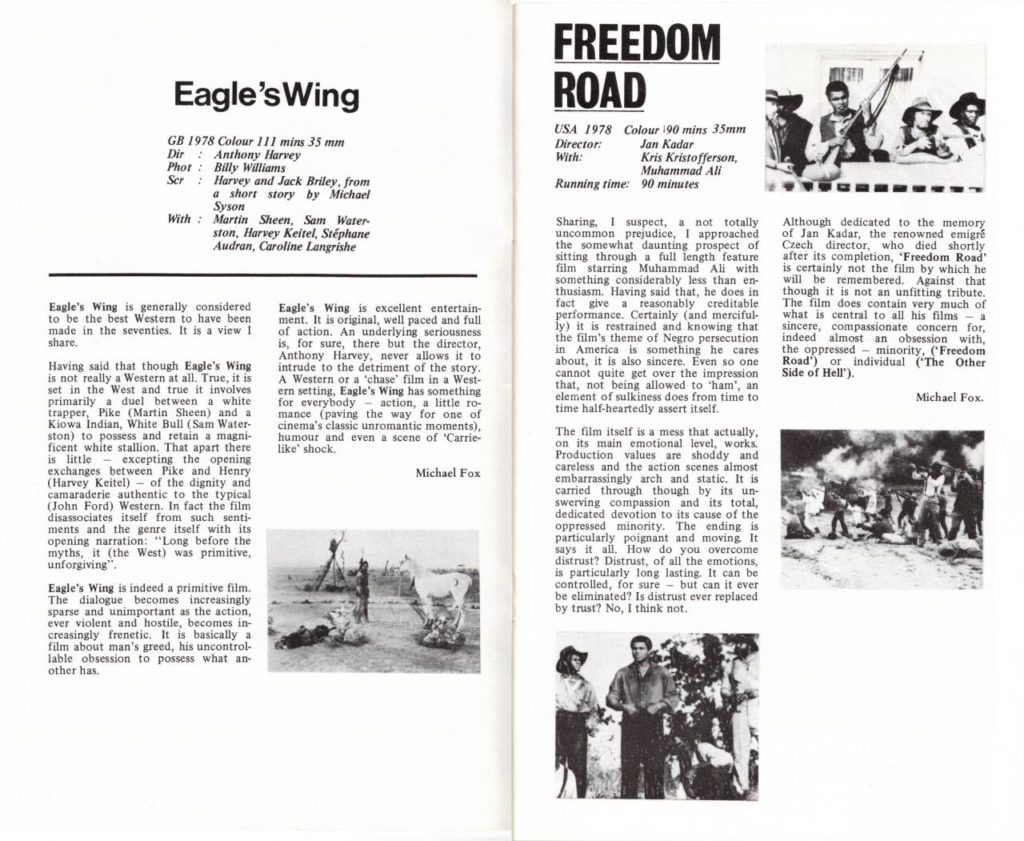 March 1981
March 1981
The passage of time continues to take its toll as I move on to March 1981. Of the four movies I saw at Studio One, I can recall only two – one became a long-time favourite, one I can recall as a fairly standard biopic – but the other two draw a complete blank, though I gave each of them a slightly higher-than-average rating. The latter two also involved some interesting people both in front of and behind the camera, so the fact that neither left a lasting impression suggests they were nobody’s best work. Anthony Harvey had been nominated for multiple awards for his second feature, A Lion in Winter (1968), but his subsequent career included a lot of hit-or-miss efforts, including the interesting misfire They Might Be Giants (1971). Eagle’s Wing (1979), the movie in question here, was a revisionist western starring Martin Sheen as a trapper and Sam Waterston (unfortunately) as a Kiowa brave who vie with one another for possession of a particular stallion. Harvey Keitel and Stéphane Audran were also involved – that cast list seems rather inappropriate for a western, and critics didn’t seem too impressed by the minimalist narrative.
Freedom Road (1979) is another movie which ought to have left a mark, if for no other reason than that it was the final work of Ján Kadár, the Czech filmmaker whose devastating The Shop on Main Street (1965) was a key work of the new wave which flourished briefly before the Soviet army rolled in to crush the Prague Spring in 1968. What I saw in Hong Kong was a cut down version of a three-hour television movie about a former slave who returns to the South after the Civil War to become a senator during Reconstruction. The oddest thing about it seems to be that it starred Muhammad Ali, admired for his skill in the boxing ring and his stand against the Vietnam War, but not known for his acting abilities. His co-star was Kris Kristofferson, so that pairing ought to have been memorable, yet … nothing.
I remember more about Steve Rash’s The Buddy Holly Story (1978), which may be most notable as the only movie ever to garner multiple best actor nominations for Gary Busey, including an Oscar nod (he was beaten by Jon Voight for Coming Home). But though I was a Buddy Holly fan, what sticks in my memory most are arguments between Busey as Buddy and Don Stroud as band-member Jesse.
The stand-out that month was Barbet Schroeder’s La vallée (1972), which until then I only knew because of the Pink Floyd soundtrack. Perhaps the hippy/counterculture trappings date it, but its dreamy mood and quest narrative still appeal to me and it remains my favourite Schroeder movie. I’ve seen it many times since on various video formats and have been transported every time.
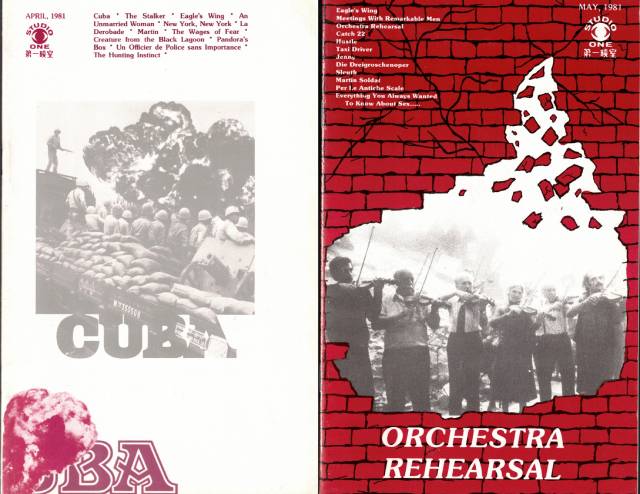
April 1981
I spent sixteen days in April, from morning to night, attending the 5th Hong Kong International Film Festival, during which I saw fifty-six films varying in length from less than an hour to over seven hours. According to my notes, in the middle of that I actually took time out to catch a commercial screening of David Cronenberg’s Scanners (1981), which had just been released. During the rest of the month I nonetheless did see four movies at Studio One – three were already familiar to me; the unknown one has, again, left no traces in my memory. That was Jean Larriaga’s Un officier de police sans importance (1973), a policier co-written by Marc Porel, an actor now very familiar from numerous gialli and poliziotteschi. I’d be interested in taking another look, but so far have only found a copy with Spanish subtitles on Internet Archive and some Russian streaming site.
The screening at Studio One of G.W. Pabst’s Die Büchse der Pandora (1929) was probably the first time I’d seen the film. If Murnau was the great poet of Weimar cinema and Lang the master of genre, Pabst was the foremost realist, a sharp observer of character and social issues with a particular interest in women and the constraints, particularly economic, which shape their lives with often tragic consequences. Based on two plays by Frank Wedekind (which were simultaneously being adapted by Alban Berg into the opera Lulu), Pandora’s Box is notable not only for Pabst’s craft, but also for creating the indelible image of Louise Brooks as a woman who takes charge of her own life and uses her considerable erotic charms to rise in society as a wealthy man’s mistress. But this society is hostile to such assertiveness and she eventually falls from the heights, becoming a prostitute in Whitechapel where her final customer is Jack the Ripper. Her punishment is cruel, but Brooks invests Lulu with so much life and energy that when she meets her end it’s not her “sins” but rather this repressive society which stands condemned.
Seeing Jack Arnold’s The Creature from the Black Lagoon (1954) on a big screen was like re-visiting an old friend. No new revelations, but a pleasant way to spend a little time with something comfortably familiar.
However, seeing George A. Romero’s Martin (1977) again proved to be very disorienting. It wasn’t the same film I’d seen three years earlier in Winnipeg, but rather the re-edited version released in Europe by Dario Argento. Not only had Donald Rubinstein’s score been replaced with music by Goblin; sequences had been re-cut and moved around. The biggest change I can recall actually made some narrative sense; the opening sequence of Martin murdering the woman on the train was moved deep into the body of the film, after Cuda had told him that he must not take anyone from the town – to assuage his craving, Martin takes the train elsewhere to find a victim. I haven’t seen this version again, so am no longer sure what other changes were made. It’s a pity that Second Sight didn’t include it on their otherwise excellent limited edition Blu-ray.
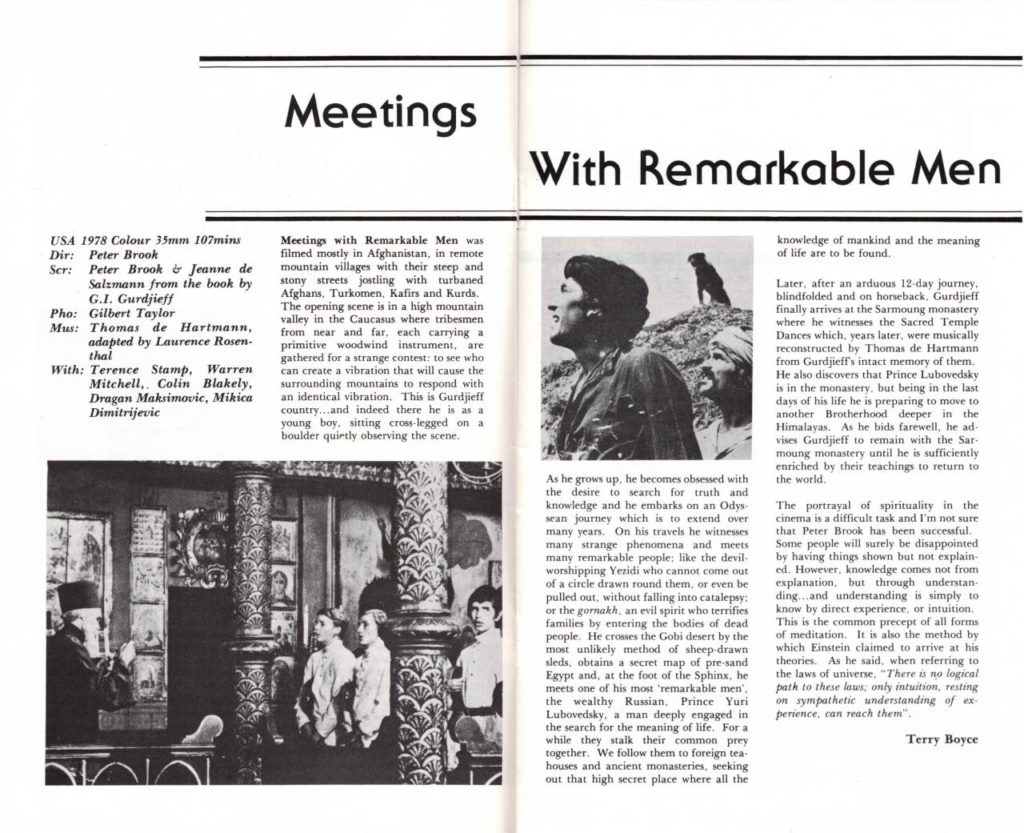 May 1981
May 1981
As I left Hong Kong part way through May, I only saw two movies at Studio One that month.
I think I considered Fellini’s Orchestra Rehearsal (1978) little more than a throwaway trifle at the time, an opinion possibly rooted in having just seen his La città delle donne (1980) at the festival, another, bigger trifle. I have a higher opinion of Orchestra Rehearsal now as a witty political allegory made with a light touch by a filmmaker in full, relaxed control of his art.
When I saw Peter Brook’s Meetings With Remarkable Men (1979) shortly before leaving Hong Kong, I knew a little about the famous mystic G.I. Gurdjieff, but had never read any of his works (though for years I had a three-volume set of his All and Everything trilogy, the middle volume of which was the basis for the film). I don’t think I actually knew anything more about him after watching the film. Brook was not primarily a filmmaker, but rather an innovative theatre director the majority of whose films were rooted in his theatre productions – which is not to say that they were merely filmed plays; he was able to visualize those productions on screen in interesting, at times visually powerful ways, as with Marat/Sade (1967), King Lear (1970) and his five-and-a-half-hour epic staging of The Mahabharata (1990). His most successfully cinematic movie is Lord of the Flies, shot on location with an improvisatory, documentary-like style.
Based on Gurdjieff’s own account of his spiritual education, the film presents a catalogue of exotic places, sumptuously photographed by Gilbert Taylor, in which the young man (Dragan Maksimovic) encounters a series of wise men who impart their wisdom and move him forward on his path to enlightenment. The film is mostly static and rather opaque (ruminations on the meaning of life are not inherently dramatic), with a cast consisting largely of familiar English actors – Terence Stamp, Warren Mitchell, David Markham, Colin Blakely, Andrew Keir – along with South African author and occasional actor Athol Fugard.
Perhaps the only thing I took away from the film as I prepared to leave Hong Kong and return to Canada was the realization that I had gained very little enlightenment from my own travels.
*
I was used to seeing a lot of movies in Winnipeg – there were many theatres back in the ’70s and ’80s and pretty much anything distributed in North America came here – but I’m a bit surprised to realize how many movies I saw during my eight months in Hong Kong; shouldn’t I have been doing something more productive with this opportunity? I did spend a week on a four-city tour of the mainland, a fascinating experience as China was only just opening up to the West after the oppressive years of the Cultural Revolution. And I visited Macau, not to mention spending three gruelling weeks trying unsuccessfully to teach English to Vietnamese refugees who were preparing to relocate to the U.S. But mostly I remember eating in a wide variety of restaurants, riding ferries to various parts of the colony, swimming off the beach in Repulse Bay, visiting markets and (certainly to me) exotic shops … and going to movies. In addition to the thirty-six films I saw at Studio One and the fifty-six I saw at the film festival, I also saw another forty in mainstream cinemas and small repertory venues[1] – 132 movies in eight months, or on average slightly more than one every two days. With so much distraction, it’s no wonder I came away without much spiritual enlightenment!
________________________________________________
(1.) Quite a few of these additional movies were similar to what I was seeing at Studio One, though I can’t recall the specific venues – many of them were no doubt put on by various European cultural organizations: Alliance française, the Goethe Institut, the British Council. The rest I saw in commercial theatres. Here’s the list, to give some idea of what was available in Hong Kong at the time:
Shogun’s Samurai (Kinji Fukasaku, 1978)
Rashomon (Akira Kurosawa, 1950)
Inferno (Dario Argento, 1980)
Sundays and Cybèle (Serge Bourguignan, 1962)
City of the Living Dead (Lucio Fulci, 7980)
Star Wars (George Lucas, 1977)
Yotsuya Kaidan (I’m not sure now whether this was Kenji Misumi’s or Nobuo Nakagawa’s film; both were released in 1959)
Battle Beyond the Stars (Jimmy T. Murakami, 1980)
Hopscotch (Ronald Neame, 1980)
Götter der Pest (Rainer Werner Fassbinder, 1970)
Fame (Alan Parker, 1980)
The Old Gun (Robert Enrico, 1975)
The Awakening (Mike Newell, 1980)
The Dogs of War (John Irvin, 1980)
The Guns of Navarone (J. Lee Thompson, 1961)
The Boogey Man (Ulli Lommel, 1980)
Flash Gordon (Mike Hodges, 1980)
Seems Like Old Times (Jay Sandrich, 1980)
Alice in den Städten (Wim Wenders, 1974)
Im Lauf der Zeit (Wim Wenders, 1976)
Die Angst des Tormanns beim Elfmeter (Wim Wenders, 1972)
Falsche Bewegung (Wim Wenders, 1975)
The Missing Link (Picha, 1980)
The Wild Geese (Andrew V. McLaglen, 1978)
The Unseen (Danny Steinmann, 1980)
Alligator (Lewis Teague, 1980)
Prom Night (Paul Lynch, 1980)
Die Dreigroschenoper (G.W. Pabst, 1931)
Ladri di biciclette (Vittorio De Sica, 1948)
Private Benjamin (Howard Zieff, 1980)
The Formula (John G. Avildsen)
Alphaville (Jean-Luc Godard, 1965)
The Stunt Man (Richard Rush, 1980)
Ordinary People (Robert Redford, 1980)
Damned in Venice (Ugo Liberatore, 1978)
Terror Train (Roger Spottiswoode, 1980)
Avengers from Hell (Li Pei-Chuan, 1981)
Scanners (David Cronenberg, 1981)
Raging Bull (Martin Scorsese, 1980)
There was also something called Little Swallow’s Song, a Chinese film I saw in Hangzhou during my one-week tour on the mainland, but I didn’t make note of the director or content and that title doesn’t come up anywhere on the Internet, so I’m not sure what it was.
I’m surprised at how many horror/exploitation movies there are in my list. I do have a very vivid memory of taking my five-year-old nephew to see Star Wars; he was bored and restless during all the action/FX sequences, but settled down and was very attentive whenever characters stopped to talk. It was a fascinating lesson in not taking other people’s subjective experiences for granted. (return)
Comments